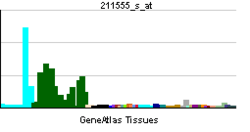GUCY1B3
| View/Edit Human | View/Edit Mouse |
Guanylate cyclase soluble subunit beta-1 is an enzyme that in humans is encoded by the GUCY1B3 gene.[3][4]
Function
Soluble guanylate cyclase (sGC), a heterodimeric protein consisting of an alpha and a beta subunit, catalyzes the conversion of GTP to the second messenger cGMP and functions as the main receptor for nitric oxide and nitrovasodilator drugs.[4]
Interactions
GUCY1B3 has been shown to interact with Heat shock protein 90kDa alpha (cytosolic), member A1[5] and Endothelial NOS.[5]
References
- ↑ "Human PubMed Reference:".
- ↑ "Mouse PubMed Reference:".
- ↑ Giuili G, Scholl U, Bulle F, Guellaën G (Jul 1992). "Molecular cloning of the cDNAs coding for the two subunits of soluble guanylyl cyclase from human brain". FEBS Lett. 304 (1): 83–8. doi:10.1016/0014-5793(92)80594-7. PMID 1352257.
- 1 2 "Entrez Gene: GUCY1B3 guanylate cyclase 1, soluble, beta 3".
- 1 2 Venema RC, Venema VJ, Ju H, Harris MB, Snead C, Jilling T, Dimitropoulou C, Maragoudakis ME, Catravas JD (Aug 2003). "Novel complexes of guanylate cyclase with heat shock protein 90 and nitric oxide synthase". Am. J. Physiol. Heart Circ. Physiol. 285 (2): H669–78. doi:10.1152/ajpheart.01025.2002. PMID 12676772.
Further reading
- Lucas KA, Pitari GM, Kazerounian S, Ruiz-Stewart I, Park J, Schulz S, Chepenik KP, Waldman SA (2000). "Guanylyl cyclases and signaling by cyclic GMP". Pharmacol. Rev. 52 (3): 375–414. PMID 10977868.
- Chhajlani V, Frändberg PA, Ahlner J, Axelsson KL, Wikberg JE (1991). "Heterogeneity in human soluble guanylate cyclase due to alternative splicing". FEBS Lett. 290 (1–2): 157–8. doi:10.1016/0014-5793(91)81248-7. PMID 1680753.
- Giuili G, Roechel N, Scholl U, Mattei MG, Guellaen G (1993). "Colocalization of the genes coding for the alpha 3 and beta 3 subunits of soluble guanylyl cyclase to human chromosome 4 at q31.3-q33". Hum. Genet. 91 (3): 257–60. doi:10.1007/BF00218267. PMID 8097486.
- Papapetropoulos A, Cziraki A, Rubin JW, Stone CD, Catravas JD (1996). "cGMP accumulation and gene expression of soluble guanylate cyclase in human vascular tissue". J. Cell. Physiol. 167 (2): 213–21. doi:10.1002/(SICI)1097-4652(199605)167:2<213::AID-JCP4>3.0.CO;2-S. PMID 8613461.
- Zabel U, Weeger M, La M, Schmidt HH (1998). "Human soluble guanylate cyclase: functional expression and revised isoenzyme family". Biochem. J. 335 (1): 51–7. PMC 1219751
 . PMID 9742212.
. PMID 9742212. - Russwurm M, Wittau N, Koesling D (2002). "Guanylyl cyclase/PSD-95 interaction: targeting of the nitric oxide-sensitive alpha2beta1 guanylyl cyclase to synaptic membranes". J. Biol. Chem. 276 (48): 44647–52. doi:10.1074/jbc.M105587200. PMID 11572861.
- Venema RC, Venema VJ, Ju H, Harris MB, Snead C, Jilling T, Dimitropoulou C, Maragoudakis ME, Catravas JD (2003). "Novel complexes of guanylate cyclase with heat shock protein 90 and nitric oxide synthase". Am. J. Physiol. Heart Circ. Physiol. 285 (2): H669–78. doi:10.1152/ajpheart.01025.2002. PMID 12676772.
- Meurer S, Pioch S, Wagner K, Müller-Esterl W, Gross S (2005). "AGAP1, a novel binding partner of nitric oxide-sensitive guanylyl cyclase". J. Biol. Chem. 279 (47): 49346–54. doi:10.1074/jbc.M410565200. PMID 15381706.
- Mateos-Cáceres PJ, Garcia-Cardoso J, Lapuente L, Zamorano-León JJ, Sacristán D, de Prada TP, Calahorra J, Macaya C, Vela-Navarrete R, López-Farré AJ (2006). "Soluble guanylate cyclase beta1-subunit expression is increased in mononuclear cells from patients with erectile dysfunction". Int. J. Impot. Res. 18 (5): 432–7. doi:10.1038/sj.ijir.3901461. PMID 16528291.
This article is issued from Wikipedia - version of the 5/28/2016. The text is available under the Creative Commons Attribution/Share Alike but additional terms may apply for the media files.
